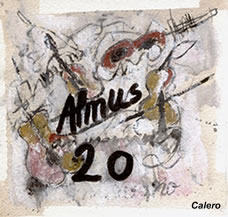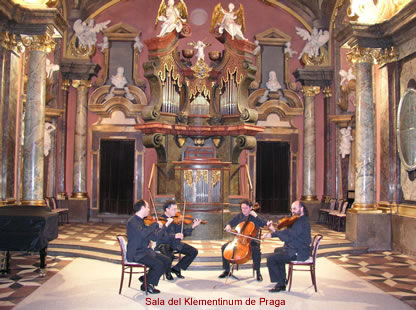| 
CUARTETO ALMUS
Manuel de Juan, Vicente Antón, violines.
Octavio de Juan, viola. Francisco Pastor, violonchelo.

Los más de veinte años de actividad ininterrumpida de este cuarteto permiten considerarlo como una de las agrupaciones camerísticas españolas más estables de nuestro tiempo. En su formación influyen decisivamente Liviu Stanese (Cuarteto Vía Nova) y Bretislav Novotný (Cuarteto de Praga). Es Cuarteto Residente de la Universidad de Alicante desde el curso 1997/98 y forma parte de los Grupos en Residencia del Auditorio de Murcia. Sus componentes son profesores de los Conservatorios de Murcia y Alicante.
A sus numerosos recitales en España (Sociedades Filarmónicas de Valencia, La Coruña, Málaga, Murcia, Segovia, Burgos, Zaragoza; Ciclos y Festivales musicales de Alicante, Ávila, Ayamonte, Barcelona, Bilbao, Madrid, Murcia, Vitoria, entre otras ciudades) hay que añadir sus giras por la República Checa, Bélgica, Francia e Italia, destacando sus actuaciones en la Gran Sala Martinu y la Capilla de los Espejos del Klementinum de Praga, en las temporadas del Moulin d´Andé, del Château de Champs, Festival Las Canals (Aveyron), Palazzo Barolo de Turín y Sala Pegasus de Spoleto.
En la temporada 2006-2007 interpretó la Integral de los 17 Cuartetos de Beethoven. El Cuarteto Almus ha actuado en el XVII Ciclo de Música de Cámara celebrado en el Palacio Real de Madrid, presidido por SS.MM. los Reyes de España, tocando los instrumentos de la famosa colección palatina construídos por Antonio Stradivarius.
En 2010 el cuarteto Almus fue galardonado por su trayectoria con la distinción Pro-Músico del Año por la Asociación Pro-Música de Murcia. El concierto conmemorativo de su XX Aniversario contó con la Presidencia de Honor de S.M. la Reina doña Sofia.
Ampliando su formación de cuarteto ha abordado los grandes quintetos del repertorio con músicos como M.Gurkova, M.Baró, F.Waysse-Knitter, P.Valero, Y.Kulaglich, J.Mª Gómez, A.Narejos, L.Magnani y G.Díaz-Jerez, pianistas; M.A. Clares, J.M.Gamard y A.L.Quintana, violonchelistas; Ch.Euler, violista; I.Rodes y P.Barón, guitarristas; J.Mozo, acordeonista; con M.Teba y M.Llamas han interpretado programas del género vocal, además de actuar junto al cuarteto de Brno.

El Cuarteto Almus es parte integral de una pionera investigación en colaboración con eminentes científicos y las Universidades Complutense y Politécnica de Madrid, Tübingen y el CSIC. Desarrolla los proyectos Artyciencia y Artyciencia Cyber Brain live experience: Beethoven y la pintura en tu cerebro en el marco de Pictomusicadelfia, en la investigación de enfermedades neurodegenerativas y del procesamiento cerebral.
THE ALMUS STRING QUARTET
Manuel de Juan, Vicente Antón, violines.
Octavio de Juan, viola. Francisco Pastor, violonchelo.
More than twenty years of uninterrupted activity of this Quartet permits to consider it as one of the most stable Spanish chamber music groups of our time. Decisive influence on its formation had Liviu Stanese (Via Nova Quartet) and Bretislav Novotny (Prague Quartet). It has been Resident Quartet at the University of Alicante since 1997 and is part of the "Groups in Residence" from Murcia Auditorium and Congress Hall. Its components are professors of the "Conservatories of Murcia and Alicante.
To numerous recitals in Spain (Valencia, La Coruña, Málaga, Murcia, Segovia, Burgos and Zaragoza's Philarmonic Societies, Cycles and music festivals of Alicante, Ávila, Ayamonte, Barcelona, Bilbao, Madrid, Murcia, Vitoria, among other cities) must be added their tours to the Czech Republic, Belgium, France and Italy, highlighting their performances in the Great Hall of Chapel Martinu and Mirrors Hall of Klementinum, Prague, in the seasons of the Moulin d'Ande, the Château de Champs (Paris), Festival The Canals (Aveyron), Palazzo Barolo (Torino) and Sala Pegasus (Spoleto).
In the 2006-2007 season it played the Integral of the 17 Beethoven quartets, being the first Spanish quartet which has performed that in the last decades. The Quartet has performed in the XVII Chamber Music Cycle held at the Royal Palace of Madrid, presided over Their Majesties Kings of Spain, playing the famous palate collection of instruments made by Antonio Stradivarius.
In 2010 the Quartet was awarded for its career with the distinction Pro-Musician of the Year by the Association for Music of Murcia. The concert commemorating the twentieth anniversary included the Honorary Presidency of SM Queen Sofia.
Expanding its formation as a quartet, Almus has addressed the major repertoire for a quintet with musicians like M. Gurkova, M. Baró, F. Waysse-Knitter, P. Valero, Y. Kulaglich, J. M. Gómez, A. Narejos, L. Magnani and G.Díaz-Jerez, pianists, M.A Clares, and A. L. Quintana, J.M.Gamard, cellists; Ch.Euler, violist; I. Rodes and P. Barón, guitarists; J. Monzo, accordionist; and with M. Teba and M. Llamas it has interpreted programs from the vocal genre, besides the cooperation with the Quartet of Brno.
 Several works by Spanish composers have been dedicated to the Almus , among which is the Salzillesca (Music for a Bethlehem) by M. Moreno-Buendia, edited on CD, and the Quartet nº 4 of M. Franco, created for the twentieth anniversary. The label RTVE has produced the CD entitled “The Humor in Chamber Music”, sponsored by the University of Alicante and the City of Mutxamel. Every once in a while two TV recordings with Almus especially produced for Intermezzo is Music are shown on TVE and other channels. Almus recorded the Beethoven's Great Fugue op.133 for the remastering of the film entitled The Man of the Crowd by Chumilla-Carbajosa, produced by Kinos Klan. The premiere of The voices of Thader by M. Franco took place at the Expo Zaragoza in 2008. For the label Audioart the Almus Quartet has recently recorded the Quartet nº 1 by E. Canet. In 2009, commemorating the Haydn’s year, Almus gave a concert at the Holy Cave of Cadiz playing The Seven Last Words of Christ on the Cross, whose live recording has been released on DVD by COLUMNA MÚSICA, sponsored by the Royal Academy of Fine Arts of Santa Maria de la Arrixaca and Pradas and Cebrián Lawyers, receiving praise from the critics. Several works by Spanish composers have been dedicated to the Almus , among which is the Salzillesca (Music for a Bethlehem) by M. Moreno-Buendia, edited on CD, and the Quartet nº 4 of M. Franco, created for the twentieth anniversary. The label RTVE has produced the CD entitled “The Humor in Chamber Music”, sponsored by the University of Alicante and the City of Mutxamel. Every once in a while two TV recordings with Almus especially produced for Intermezzo is Music are shown on TVE and other channels. Almus recorded the Beethoven's Great Fugue op.133 for the remastering of the film entitled The Man of the Crowd by Chumilla-Carbajosa, produced by Kinos Klan. The premiere of The voices of Thader by M. Franco took place at the Expo Zaragoza in 2008. For the label Audioart the Almus Quartet has recently recorded the Quartet nº 1 by E. Canet. In 2009, commemorating the Haydn’s year, Almus gave a concert at the Holy Cave of Cadiz playing The Seven Last Words of Christ on the Cross, whose live recording has been released on DVD by COLUMNA MÚSICA, sponsored by the Royal Academy of Fine Arts of Santa Maria de la Arrixaca and Pradas and Cebrián Lawyers, receiving praise from the critics.
The Almus Quartet is crucial part of a pioneering international research through behavioral and electrophysiological experiments in collaboration with eminent scientists and universities like Complutense University, Polytechnic University and CSIC (Spanish National Research Council) through the CTB (Center for Biomedical Technology) all of them of Madrid, University ofTübingen (Germany) and with the Projects Artyciencia and Artyciencia Cyber Brain: live experience: Beethoven and paint in your brain, within the framework of the Pictomusicadelfía in the investigation of diseases such as autism, Down's syndrome, Alzheimer's and other neurodegenerative diseases as well as with the musical neuronal processing particularly and the general neuronal cerebral activation.
|
|